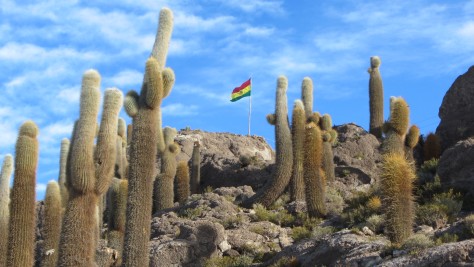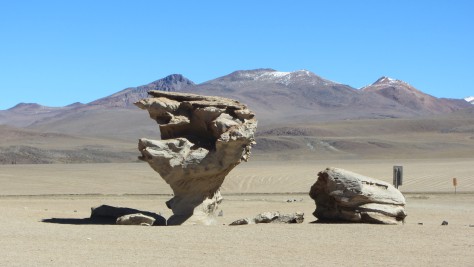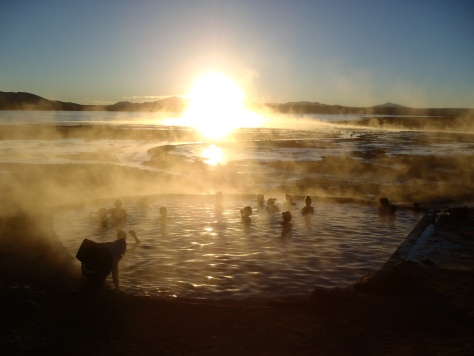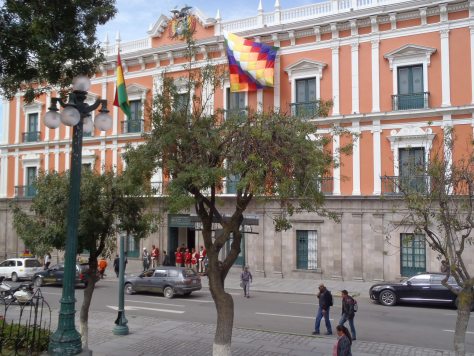LA PAZ, UYUNI, COLCHANI, SALAR DE UYUNI
The largest salt desert in the world with a mirror effect, huge cacti, and salt hotels at an altitude of almost 5000m? That’s all we needed…
Depart from Cusco – Arrival to Uyuni
From Cusco to the Bolivian capital La Paz (Bolivia is probably the only country with two capitals, La Paz and Sucre) we arrived around noon and we found out our 2x changed flight was at the end canceled and we had to wait for an evening flight to Uyuni. These things are in South America completely normal so it’s good to be prepared and have some time reserved. We board the flight at the end and after a short 45 minutes flight, we landed in the small desert town of Uyuni. We had a 3-day Jeep tour booked for tomorrow but we still had to go to the agency today to confirm our reservation.

Day 1 Jeep tour – Salar de Uyuni
Uyuni is a small dusty town like in the Western movies and it’s only known thanks to its location near the world’s largest salt desert – Salar de Uyuni. Once known for the mining industry but now it lives only from tourism. We came to the Red Planet Expedition agency before lunch to drop all unnecessary things and the rest was placed on top of “our” Toyota Landcruiser 4×4 and headed into the desert. Salar de Uyuni is with an area of more than 10,000 square kilometers the largest salt desert in the world. It is 10 times bigger than Lake Titicaca.
Thanks to regular rainfalls it is a renewable resource and as we were told annual increase in salt is 1 cm. It may seem to be a small number but because of the size of the desert, it is quite a big number. Estimates say that there are about 10 billion tons of salt in the desert of which 25 thousand tons have been pulled so far. If Bolivia would have a little better relations with Chile and therefore also access to the sea they could be the largest exporter of salt in the world.

Our first stop after a short ride was the train cemetery. It is a place where the remains of trains and wagons remained after the end of mining. The next stop was a little salt town Colchani where salt saturation is processed and packaged and where locals sell all sorts of products and souvenirs from the salt and also clothing from alpaca. After visiting the salt factory it was the right time to go for lunch. We were glad to continue on the trend of the Inca trail because the food was excellent. More than the food I was impressed with the area where we ate. A large room built completely from the salt. Table and chairs were made from salt blocks, covered with small pillows made of alpaca leather, and even the bed and walls were created from salt blocks.
After lunch, there was the main point of today which was the visit to the salt desert. First, we stopped at the salt hills created with salt shovels into a tapered shapes so that the salt can dry in the sun. Then we moved right to the middle of the desert where warm and dry weather created polygonal shapes on the ground. Everywhere only white salt, blue sky, and nothing else. Unbelievable.

From there we then went to a famous Salt hotel that once served as accommodation but now it’s just a stop for a snack or souvenir shopping. Nevertheless, it is a very well-known and popular place with flags from all around the world and is also a stop of every expedition including the legendary Dakar race. If you saw the Trabant expedition in South America the original Slovak flag was missing there. I decided to fix it and from now on there is proudly blowing our flag also with our names.

The next stop was the nearby cactus island of Isla Incahuasi. The island itself looks a bit bizarre when you think of huge salt deserts and in the middle of nowhere suddenly grows up a 24-hectare island full of giant cacti. The largest of them grows up to 15 meters in height.

Really an amazing place to rest and take a few pictures. From there we continued south of the Salar territory which was lined with mountains and volcanoes with a height of up to 6,000 meters. Just before nightfall, we arrived at the hotel which was as well made from salt, and certainly, that was also the reason for our good sleep.
Day 2 Jeep tour – Lagoons a volcanoes
Today we had to wake up about an hour earlier than usual because of the election. The fact that the Bolivian election system requires 100% attendance and the prohibition of any work on election day made our drivers a little bit uncomfortable. We had to stay away from all the communities and towns where elections were held otherwise they could be given heavy fines. This day was completely eye-catching because of so many different colored hills, rocks, caves, volcanoes, and lagoons which are not easily seen that often…

We stopped at 4 lagoons and in three of them, we could see also a few flamingos. To see them in the wild as they feed with shrimps in a mountain lagoon was a real experience. But we still did not know what awaits us later. After a short drive, we entered the park where we purchased the tickets and continued our journey. When we finally stopped we were blown away by what we saw. We have been to Laguna Colorada. It is a deep, red, the most famous lagoon in Bolivia with hundreds of flamingos looking for food, and in the background, you can see snowy hills and volcanoes. Exactly like from the postcard.
After this stop, we continued to drive along the border with Chile and even when I tried to convince our driver and guide in one person – Wascar to cross the border with at least one wheel, he refused. Not only because of the fact that Bolivia and Chile are not in the best relations but also because we had quite a busy schedule. The next stop was a small park dominated by a stone Rock tree surrounded by similarly scattered boulders.

I couldn’t resist and climbed on one of them. Until then we mistakenly thought the Dead Woman’s pass from the Inca trail with its 4215 meters was the highest peak of our trip in South America but then Wascar – our driver told us we are at 5000 meters above sea level. Our new height record. Another shortstop was the 7-colored mountain on the border with Chile and then we have already gone to Sol de Manana geysers full of smoke and smelly sulfur. They are in fact giant holes in the ground loudly blowing steam and smoke and next to them are lakes with hot mud. Amazing natural theater…
That was the last stop for today and as soon as we moved we had a puncture. We were maybe just 20 minutes away from the hostel when it happened. We could have made those last meters by walk but it was not necessary because Wascar was not only a man full of information but also a skilled technician and replaced the wheel in 10 minutes. I asked him if he needs any help but he had it under control. Real pro… Finally, we successfully reached the accommodation and there was one more surprise waiting for us. About 100m from us was a pool with thermal springs of Aguas Termales.

As soon as we ate it was already dark outside which means the best time for bathing under the stars. For me, it is worse when the water is hot than cold and this one was about 35’C hot so it took me a while until I got in. Once I bathe in October in the cold waters of Banska Stiavnica and I had no problem with that but this boiling water was a bit too much for me.
The best thing about the whole swimming was the starry sky above us. So far the clearest night sky I have ever seen was on a hike to Borisov at home in Slovakia but this was another class. The moon shines as an interrogation lamp and in the center of the whole sky with the Milky Way shone Big and Little Dipper, Orion, and other constellations. I know such clear visibility was also due to the fact we were far away from any lights so there was no light pollution but this show was really simple and beautiful. And as a bonus to this space theater when you are just bathing in the warm water our Czech friends pulled out a homemade plum brandy. Fantastic ending to the day…
Day 3 Jeep tour – Back to Uyuni
The last day of our desert trip was planned with two stops. The first one was the rocks of Salvador Dali with the stone formation that resembled some of his art and the other one was a very photogenic Green Lake lying in front of the volcano Licancahur. After a short drive, we entered a little desert town where we had our last lunch. It was a small village with a church and a little square where kids were playing football. After a few more hours of driving on the dusty roads and in the evening, we were back in Uyuni. We said goodbye to our driver and got ready for a bus ride to the capital La Paz.
The journey from Uyuni to La Paz usually takes about 10-12 hours but we were a bit worried because some of our friends on the trip came by bus the other way round and with several hours of delay due to flooding. It took them 30 hours to get to Uyuni.

La Paz
Fortunately, everything went according to plan and in 10 hours we were in La Paz. Not only the city also started slowly to wake up and local aunts began to put their stuff on the pavement from where they are selling their goods all day. They have everything you can imagine from fruits and vegetables to clothes and souvenirs. Since we had just one day in La Paz we went to the hotel to get rid of baggage, get some rest, and back to the streets. Our first stop was the cafe in the center of town near the presidential palace on Plaza Murillo where we met with our friends from Uyuni and went to explore the city with them.

We were told that La Paz is the most beautiful from above so we took a taxi to the cable car terminal. It has 3 lines (green, yellow, and red). First, we’ve tried the green line to the very top of El Alto. On the way up you can see the differences between the various social classes. In comparison with Europe here is everything another way around. The rich people here live at the bottom and the poor up in the hills but with the best view. La Paz from above is really amazing. A large town in a valley surrounded by high mountains from there looks quite different. We switched to the yellow cable car route and continued further into the southern part of town and then back again.

Tip 2: If you want to buy some souvenirs on your way to Salar de Uyuni do it on your first stop in Colchani town.
Tip 3: When you come to Plaza San Francisco try the delicious Bolivian snack Api.
Total costs: 20 nights (Brazil + Peru (Inca trail) + Bolivia): £1720.00
(Prices as of March 2015)
Thank you very much for reading this article. If you have any questions, suggestions, or ideas please write them in the comment box below.

